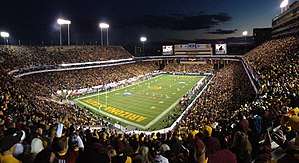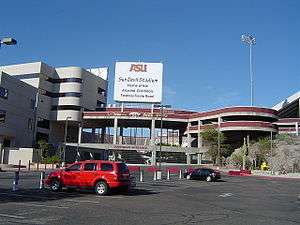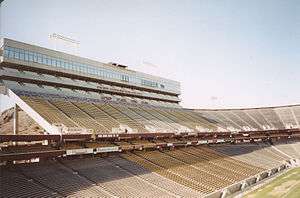Sun Devil Stadium
Sun Devil Stadium is an outdoor football stadium on the campus of Arizona State University in Tempe, Arizona, United States. It is home to the Arizona State Sun Devils football team of the Pac-12 Conference. The stadium's seating capacity as of 2018 is 53,599, reduced from a peak of 74,865 in 1989. The natural grass playing surface within the stadium was named Frank Kush Field in 1996 in honor of the former coach of the Sun Devil football team.[7] The stadium underwent a five-year, $304-million renovation that was completed in August 2019.[8][9][10][11] It was the only major football stadium in the Phoenix metropolitan area until the construction of State Farm Stadium in Glendale in 2006.
 Sun Devil Stadium hosting the 2013 Pac-12 Football Championship Game | |
 Sun Devil Stadium Location in Arizona  Sun Devil Stadium Location in the United States | |
| Location | 500 East Veterans Way Tempe, Arizona 85281 |
|---|---|
| Coordinates | 33°25′35″N 111°55′57″W |
| Public transit | |
| Owner | Arizona State University |
| Operator | Arizona State University |
| Capacity | 53,599 (2018–present)[1] |
| Surface | Bermuda Grass |
| Construction | |
| Broke ground | January 1958 |
| Opened | October 4, 1958[2] |
| Renovated | 2015–2018 |
| Expanded | 1966, 1970, 1976, 1977, 1989 |
| Construction cost | $1 million (original stadium) ($8.86 million in 2019 dollars[3]) |
| Architect | Edward L. Varney Associates[4] |
| General contractor | F. H. Antrim Construction Company[5] |
| Tenants | |
| Arizona State Sun Devils (NCAA) (1958–present) Fiesta Bowl (NCAA) (1971–2006) Arizona Wranglers (USFL) (1983–1984) Arizona Outlaws (USFL) (1985) Phoenix/Arizona Cardinals (NFL) (1988–2005) Cactus Bowl (NCAA) (2006–2015) Arizona Hotshots (AAF) (2019)[6] | |


The stadium has hosted two annual college football bowl games: the Fiesta Bowl from 1971 to 2006, and the Cactus Bowl from 2006 to 2015.
Sun Devil Stadium was also home to the Arizona Cardinals of the National Football League (NFL) from 1988 through the 2005 season. Following the 2005 season, the Cardinals moved to State Farm Stadium.
Construction and upgrades
Built in 1958, the stadium's original capacity was 30,000. The first addition in 1976 substantially raised the capacity to 57,722. Seating was added to the south end zone, along with press and sky boxes. A year later, in 1977, the upper tier was completed to bring seating to 70,311. In 1988, 1,700 more seats were added. During that time the Carson Student Athlete Center was added to the south end. The building is the home of the ASU Athletic Department.
In 2007, engineers realized the stadium's concrete base was buckling due to the rusting of structural steel supporting the foundation. Stadium designers and constructors had failed to account for a need to waterproof the structure when it was built, assuming a stadium in the desert would not need hydrophobic concrete. However, they did not take into account that the cleaning/maintenance crews for the Sun Devils (and later, the Cardinals) would use pressure washers, along with chemicals, to clean the seats and rows of the stadium after every game and event. The 1958 designers had also not foreseen the stadium, thought to be only used for a number of Saturdays and limited college events per year in what was then a small market, would be the home of an NFL team and the site of a major college bowl game and multiple concerts by the early 90s as Metro Phoenix's growth exploded. This introduced substantially more water to the stadium than the designers had ever envisioned. Engineers estimated $45 million in repairs would be needed to maintain the stadium beyond 2010.[12]
A new Arizona bill allows the Arizona Board of Regents to set up a district on ASU property to collect revenue from local businesses. Money from the fee will go toward the funding of renovation projects of ASU's athletic facilities, including the stadium. It was estimated the fund would accumulate enough money to begin planning renovations within 2–5 years (2012–2015).[13]
In April 2012, Sun Devil Athletics unveiled an estimated $300-million plan to renovate Sun Devil Stadium that entailed reducing stadium capacity to the 55,000–60,000 seat range, field turf, and fabric roof shading.[14] The plan to cover the stadium with a roof was later scrapped to reduce costs. In October 2013, Sun Devil Athletics announced the removal of approximately 5,700 north endzone upper-deck seats that would reduce the stadium capacity to 65,870 for the 2014 season.[15] The Cactus Bowl, which is usually played in Sun Devil Stadium, were played at nearby Chase Field in 2016 and 2017 while the renovations took place.
The renovations were originally intended to consist of three phases that would each take place between football seasons, thus removing the need for the team to play one or more years at a temporary home venue during construction. Initial plans called for the entire project to be completed in time for the start of the 2017 season, but modifications to the renovation schedule have postponed the anticipated completion date to 2019.[8][9][10]
- Phase 1 (2015): Sections of the upper deck were removed. The bleachers behind the south end zone were replaced with a steel and concrete structure.
- Phase 2 (2016): The west side of the lower bowl and loge level was demolished and rebuilt. Construction began on an athletic facility on the north end of the stadium.
- Phase 3 (2017): Completion of the athletic facility and installation of a new video board above the north end zone.
- Phase 4 (2018): The east side of the lower bowl was rebuilt.[10]
- Phase 5 (2019): Club areas were completed.[11]
The upgrades include a new scoreboard that was the eighth largest in college football at the time of its installation, and is slightly wider than that of Arizona Stadium, the home of the rival Arizona Wildcats football team.[16] The Coca-Cola Sun Deck is a small standing room only concert venue is located on the north side of the stadium.[17] The 365 ASU Community Union was created so the stadium could be used for non-football events, including concerts, movie nights, yoga, and community events.[18]
College football
The first game played at the stadium was on October 4, 1958. Arizona State defeated West Texas State 16–13.
On September 21, 1996, the playing surface was named "Frank Kush Field" in honor of former ASU football coaching great Frank Kush. Kush became head coach in the same year Sun Devil Stadium opened; reflecting the Sun Devils' rise to prominence under his watch, the stadium's capacity more than doubled during his 21-year tenure. That night ASU shut out #1 Nebraska 19–0. The largest crowd ever seated for a college football game at the stadium was 80,470 for the 1999 Fiesta Bowl, where the Tennessee Volunteers beat the Florida State Seminoles, 23–16 on January 4, 1999 to win the National Championship.
Sun Devil Stadium hosted the Fiesta Bowl from 1971 to 2006. During the 1998 and 2002 seasons, the Fiesta Bowl doubled as the BCS National Championship Game.
The Cactus Bowl (formerly called the Buffalo Wild Wings, Insight and Copper Bowl) moved to Sun Devil Stadium from Chase Field in 2006, after the Fiesta Bowl relocated to the newly opened State Farm Stadium in Glendale.
| Years | Capacity |
|---|---|
| 2018–present | 53,599[1] |
| 2017 | 57,078[19] |
| 2016 | 56,232[20] |
| 2015 | 64,248[21] |
| 2014 | 65,870[22] |
| 2004–2013 | 71,706 |
| 1996–2003 | 73,379 |
| 1992–1995 | 73,473 |
| 1989–1991 | 74,865 |
| 1987–1988 | 70,491 |
| 1983–1986 | 70,021 |
| 1980–1982 | 70,330 |
| 1978–1979 | 70,311 |
| 1976–1977 | 57,722 |
| 1970–1975 | 50,300 |
| 1966–1969 | 41,000 |
| 1958–1965 | 30,450 |
NFL
The first professional football game played in the stadium was a National Football League (NFL) preseason game between the New York Jets and the Minnesota Vikings in 1975. The NFL returned to the stadium in 1987 when the Green Bay Packers played the Denver Broncos in a preseason game.
Sun Devil Stadium was the home stadium of the Arizona Wranglers/Outlaws of the USFL from 1983 to 1985.
The facility became an NFL stadium in 1988 when the St. Louis Cardinals moved west to Arizona and became the Phoenix Cardinals, renamed the Arizona Cardinals in 1994. The Cardinals' first regular season game in the stadium was a 17–14 loss to the Dallas Cowboys in a Monday Night Football game on September 12, 1988. The Cardinals won their next home game, defeating the defending Super Bowl champion Washington Redskins 30–21. The Cardinals intended to only play in Sun Devil Stadium temporarily until a new stadium could be built in Phoenix. However, the savings and loan crisis derailed plans for a permanent home, and the Cardinals remained in Tempe for 18 years. In the latter part of that time, the Cardinals began chafing at being merely a tenant in a college-owned stadium; they felt it denied them access to revenue streams that other NFL teams took for granted. The 18 seasons the Cardinals spent at ASU are by far the longest a professional football team has been a tenant in a college stadium since the formation of the American Football League in 1960.
The stadium hosted Super Bowl XXX in 1996 as the Cowboys won their fifth Vince Lombardi Trophy, defeating the Pittsburgh Steelers, 27–17 in front of 76,347 spectators.
On October 27, 2003, the Monday Night Football game between the San Diego Chargers and Miami Dolphins was moved to Sun Devil Stadium because the Cedar Fire in the San Diego area forced the teams to vacate Qualcomm Stadium, which was being used as an evacuation site. Tickets for the game were free and the capacity crowd saw the Dolphins win 26–10. It was the first Monday Night Football game in the stadium in four years.[23]
The Cardinals ended their tenancy at Sun Devil Stadium with a 27–21 victory over the Philadelphia Eagles on Christmas Eve 2005. In 18 seasons, the Cardinals compiled a 64–80 (.444) record at the facility, their best home record being 5–3 which they achieved four times: 1994, 1996, 1998, and 2004.
Whenever the Cardinals struggled, Sun Devil Stadium was frequently one of the quietest stadiums in the league. Cardinals home games often did not sell out in time for them to be aired locally, in compliance with NFL blackout policy at the time. The few fans who did show up for games were most often rooting for the visiting team, creating what amounted to "home games" on the road for many opposing teams. A significant percentage of the state's residents only live there during the winter and live elsewhere for the rest of the year, and many of Arizona's permanent residents either grew up in other states or have roots outside the state.[24] In 2005, for instance, all home games (except for the 49ers game which was held at Estadio Azteca in Mexico City) failed to sell out and could not be broadcast on local television.
In 2006, the Cardinals moved from Sun Devil Stadium to University of Phoenix Stadium in another Phoenix suburb, Glendale, located on the opposite side of the metro area from Tempe (although the Cardinals' training facility is in Tempe). The new stadium also hosts the Fiesta Bowl, and hosted the first stand-alone BCS National Championship Game in January 2007.

The stadium was also home to a new professional football team, the Arizona Hotshots. The team began play in February 2019 and was a part of the Alliance of American Football[25], but the league folded in April 2019.
Film appearances
Sun Devil Stadium has been the setting for several movies over the years. Some of them include Cameron Crowe's 1996 blockbuster film Jerry Maguire, U2's 1988 rockumentary Rattle and Hum, The Rolling Stones' 1982 concert film Let's Spend the Night Together, 1976's A Star is Born, with Barbra Streisand and Kris Kristofferson,[26] the Coen Brothers' 1987 film Raising Arizona,[27] and the 1980 film Used Cars. In 2003, the stadium was also featured on the finale episode of The Amazing Race 4, and in 2009 The U in ESPN's 30 for 30.
Historic appearances
Pope John Paul II visited Phoenix on September 14, 1987, as a part of his whirlwind tour of the United States. In Tempe, he held Mass for 75,000 at Sun Devil Stadium, which had all images and textual mentions of the Sun Devil mascot and nickname removed or obscured in his presence.[28]
References
- Metcalfe, Jeff (August 31, 2018). "Herm Edwards Era Begins at ASU Football with Defense Again As the Great Unknown". The Arizona Republic. Phoenix. Retrieved September 3, 2018.
- "Sun Devil Stadium". Sports-Venue.info. Retrieved September 7, 2011.
- Federal Reserve Bank of Minneapolis. "Consumer Price Index (estimate) 1800–". Retrieved January 1, 2020.
- "Bids for New Sun Devil Stadium to Be Accepted". Prescott Courier. November 15, 1957. Retrieved September 26, 2011.
- Solliday, Scott (December 1, 2001). "Tempe Post-World War II Context Study". City of Tempe. Retrieved November 6, 2013.
- "SArizona awarded new pro football team, will play at Sun Devil Stadium". ABC 15 Arizona. Retrieved May 16, 2018.
- Metcalfe, Jeff (June 22, 2017). "Legendary ASU Coach Frank Kush Dies at 88". The Arizona Republic. Phoenix. Retrieved September 3, 2018.
- Metcalfe, Jeff (February 11, 2016). "See What Sun Devil Stadium Will Look Like After Renovation". The Arizona Republic. Phoenix. Retrieved September 12, 2016.
- Metcalfe, Jeff (October 12, 2016). "ASU Postpones Final Sun Devil Stadium Reconstruction". The Arizona Republic. Phoenix. Retrieved March 21, 2017.
- Leingang, Rachel (August 31, 2018). "Here's What You Need to Know About Sun Devil Stadium's $307M Renovation Before Game Day". The Arizona Republic. Phoenix. Retrieved September 3, 2018.
- "ASU completes five-year Sun Devil Stadium renovation". azcentral. Retrieved 2019-08-29.
- "Sun Devil Stadium Repairs Planned". The Arizona Republic. Phoenix. June 24, 2007. Retrieved December 30, 2007.
- Ottens, Cale (September 26, 2010). "Business Fee to Fund Sun Devil Stadium Renovation". State Press. Arizona State University. Retrieved December 1, 2010.
- Boor, William (April 4, 2012). "ASU Unveils Plans for Renovated Sun Devil Stadium". State Press. Arizona State University. Retrieved November 8, 2013.
- Metcalfe, Jeff (October 3, 2013). "ASU to Demolish Upper-Deck Seating in North End Zone at Sun Devil Stadium in January". The Arizona Republic. Phoenix. Retrieved November 6, 2013.
- https://www.statepress.com/article/2017/06/spsports-asu-football-new-video-board
- https://www.asu365communityunion.com/
- https://www.asu365communityunion.com/experience
- "2017 ASU Football Final Guide" (PDF). Arizona State University Department of Athletics. August 28, 2017. Retrieved September 10, 2017.
- Haller, Doug (August 23, 2016). "Renovated Sun Devil Stadium Ready for Sept. 3 Opener". The Arizona Republic. Phoenix. Retrieved September 5, 2016.
- Boivin, Paola (July 17, 2015). "ASU Has High Hopes for Splitting Student Section". The Arizona Republic. Phoenix. Retrieved August 31, 2015.
- "A Closer Look at the Pac-12's Football Stadiums". The Arizona Republic. Phoenix. August 1, 2014. Retrieved August 3, 2014.
- Baum, Bob (October 28, 2003). "Dolphins 26, Chargers 10". Yahoo! Sports. Associated Press. Retrieved April 28, 2010.
- Boeck, Greg (October 23, 2003). "Cardinals Feel the Heat". USA Today. Retrieved January 28, 2013.
- "Alliance of American Football". aaf.com.
- "Sun Devil Stadium, Tempe Arizona 1976". Barbra Streisand Archives. Retrieved October 3, 2013.
- "Raising Arizona Movie Filming Locations". The 80s Movies Rewind. Retrieved October 3, 2012.
- Komiya, Emi (September 23, 2015). "Only Pope to Ever Visit AZ Held Mass at Sun Devil Stadium". KPNX. Phoenix. Retrieved September 4, 2016.
External links
- TheSunDevils.com – official athletics site – Sun Devil Stadium, Frank Kush Field
- Ballparks.com: Sun Devil Stadium
- Stadiums of Pro Football: Sun Devil Stadium
| Events and tenants | ||
|---|---|---|
| Preceded by none |
Home of the Tostitos Fiesta Bowl 1971–2005 |
Succeeded by University of Phoenix Stadium |
| Preceded by Chase Field |
Home of the Insight Bowl 2006–present |
Succeeded by Current |
| Preceded by Busch Stadium |
Home of the Arizona Cardinals 1988–2005 |
Succeeded by University of Phoenix Stadium |
| Preceded by Joe Robbie Stadium |
Host of the Super Bowl XXX 1996 |
Succeeded by Louisiana Superdome |
| Preceded by first stadium Rose Bowl |
Home of the BCS National Championship Game 1999 2003 |
Succeeded by Louisiana Superdome Louisiana Superdome |